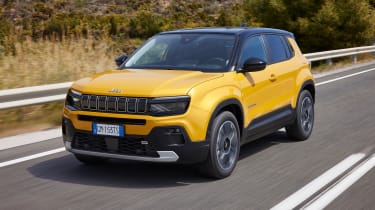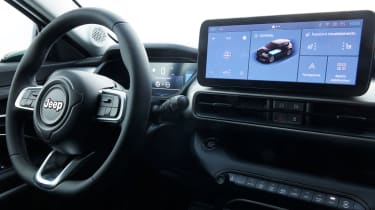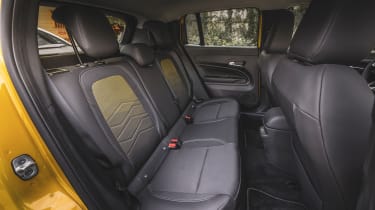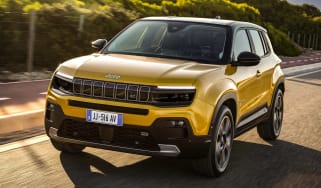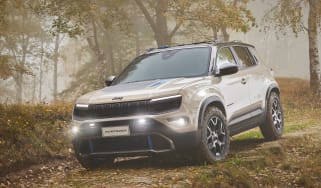New Jeep Avenger 2023 review
The new Avenger is all-electric and two-wheel-drive, so is it a proper Jeep?
Verdict
If you remove any preconceptions about what you think a Jeep should be – and on this evidence, we reckon you’d be wise to do just that – then the new Avenger is a really capable small SUV. It’s efficient, good to drive and cleverly packaged, and there’s plenty of charm and style on offer. If you do want a proper 4x4, you’ll be able to buy an all-wheel drive Avenger from 2024.
In the same way we never expected to see the likes of Ferrari, Lamborghini and Aston Martin build an SUV, a Jeep without any true off-road prowess could be considered sacrilege in the eyes of brand purists around the world.
And yet, with the compact SUV segment now the second-biggest in Europe, and Jeep looking to extend its low and zero-emission reach in key markets, the maker is using all of parent company Stellantis’s platform know-how, launching its first EV in two-wheel-drive form.
We were treated to a slightly sanitised first drive in a pre-production prototype late last year, on closed roads around the firm’s Balocco test track in Italy. But this is our first taste of the car due in showrooms in the coming months.
Jeep’s smallest model gets parent firm Stellantis’s latest battery and motor tech, which means a 54kWh (51kWh usable) battery for a maximum range of up to 248 miles. That’s less than cars such as the Hyundai Kona Electric, but still competitive.
Charging is, again, on par with most of Jeep’s rivals, but not class-leading. The Avenger’s 100kW maximum charging speed is still enough for a 20-80 per cent top-up in 24 minutes, though.
The Avenger is a compact car – one of the smallest in its class, in fact. At 4,084mm long it’s 126mm shorter than a Nissan Juke, and 216mm shorter than the Peugeot 2008, despite sharing that car’s basic platform. The Jeep’s tiny front and rear overhangs, wide track and significant 200mm of ground clearance give it a chunky look, while inside the Avenger feels roomy – even for adults over six-feet tall. There is loads of headroom, and legroom is adequate; few crossovers are as spacious in the rear. The 380-litre boot matches the load space of some family hatchbacks, and a one-metre-wide opening boosts practicality.
Quality is good, and the layout is logical. You can even colour-code the dash to match the exterior paint. Jeep claims there is 34 litres of storage in the forward cabin – enough, apparently, to stash the contents of a carry-on suitcase among its various cubbies. The one below the central infotainment screen is particularly useful; accessed via a tablet-style magnetic cover, it’s deep, and in top-spec cars, hides a handy wireless phone charger.
The infotainment system is a big improvement on older Jeep tech. At 10.25 inches the screen is a good size, and it’s responsive. Standard-fit wireless Apple CarPlay and Android Auto ensure connectivity is on point, too. Thankfully, the climate controls sit on a row of piano-style buttons underneath the main display.
Jeeps have often compromised on-road manners for their ability off-road, but the Avenger’s dynamic ability is genuinely good. Despite that generous ground clearance the car’s inherently stiff structure and firm suspension means body control is very good. It’s not at the expense of comfort either, though.
The steering could do with a bit more weight and feel, but the upside is a car that’s super-easy to drive around town. Further to this, in an urban environment, the 154bhp e-motor feels punchy enough. It’s only pulling onto motorway slip roads or when overtaking that the Avenger can feel a little short on shove.
The brake regeneration isn’t strong enough to allow for one-pedal driving, but it slows the car sufficiently, while Jeep claims it has the ability to send enough energy back into the battery to extend that 245-mile range up to 360 miles in slow speed, stop-start traffic. We weren’t able to truly test this claim, but the range readout appeared accurate for the most part.
It may have just one motor – a 4xe all-wheel drive car is coming in 2024 – but Jeep hasn’t totally neglected the Avenger’s competence off-road. In addition to the usual Eco, Normal and Sport drive modes, there are Mud, Sand and Snow settings, as well as a hill descent system. Our experiences were limited to lightly rutted dusty tracks, but we’d wager the Avenger could show its SUV rivals a clean pair of heels over wet or slippery terrain.
The Avenger line-up is relatively simple. Prices start from £34,800, undercutting the Vauxhall Mokka Electric by more than £4,000. A trio of trims allow buyers to choose the Jeep that suits their needs, with even entry-level Longitude models getting 16-inch alloy wheels and automatic LED lights, plus climate control and that 10.25-inch display with CarPlay and Android Auto.
Stepping up to Altitude (+£1,700) brings a larger digital dash, 17-inch wheels, keyless entry and a power tailgate, plus different interior trim and an additional USB port in the rear. Top-spec Summit cars like ours (from £39,100) get level 2 autonomous drive functions, 18-inch wheels, heated seats and a reversing camera, among other extras. Option packs can be added to all trims, packaging key bits of kit together.
Jeep claims the extensive cladding, which is allegedly more durable than painted bumpers and side skirts – as well as features such as the inset headlamps – could save owners up to €1,000 (£880) over the lifetime of the car.
| Model: | Jeep Avenger Summit 54kWh Auto |
| Price: | £39,100 |
| Powertrain: | 51kWh battery, 1x e-motor |
| Power/torque: | 154bhp/260Nm |
| Transmission: | Single-speed auto, front-wheel drive |
| 0-62mph: | 9.3 seconds |
| Top speed: | 93mph |
| Range/charging: | 245 miles/100kW, 20-80% in 24 mins |
| On sale: | Now |
For an alternative view see our sister site DrivingElectric's review of the Jeep Avenger...

